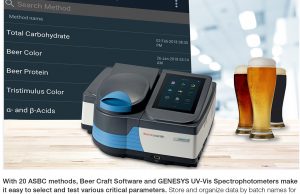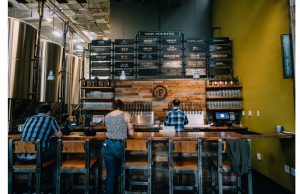
To create award-winning artisanal beer with a unique Pacific Northwest hometown flair, pFriem Family Brewers took inspiration from great Belgian and German brewers. Their Quality Laboratory Manager, Max Kravitz, shares how their testing processes ensure consistent quality and flavor and the added benefits provided by integrating UV-Vis spectrophotometry methods.
- Could you provide a brief introduction to pFriem Family Brewers? pFriem is a 15 barrel (bbl) brewery located in beautiful Hood River, Oregon. We make over 120 unique styles of beer a year with emphasis on classic German lagers, hop-forward American ales, and traditional Belgian-inspired beers.
- What is your brewery’s yearly capacity? We are on track to brew ~30,000 bbls of beer in 2019.
- What kind of quality testing procedures do you use in your brewery? What tests do you perform, what equipment do you use, how often do you test, etc.? We have dozens of quality checkpoints for every single batch of beer, which extend from the brewhouse all the way to the final package and beyond. Our on-site quality laboratory focuses on yeast quality, fermentation consistency/performance, microbiological testing, packaging quality, refermentation monitoring, and sensory panels. We use a variety of different instrumentation from optical dissolved oxygen meters, carbon dioxide meters, densitometers, pH meters, turbidimeters, spectrophotometers, amongst many others.
- Do you have any examples, from your own experience, that demonstrate the value of UV-Visible (UV-Vis) spectrophotometry for QA/QC testing? Dry hopping beers is a critical component to all of our hop-forward beers. However, the process of dry hopping has proven to disrupt the maintenance of otherwise terminal vicinal diketone (VDK) values*. This phenomenon has led to cellaring nightmares with highly extended VDK stands that had numerous negative quality impacts on the beer. With VDK quantification by [UV-Vis] spectrophotometry, we were able to identify key variables in our dry hopping process that not only allowed us to avoid this issue, but greatly improve the hop flavor, aroma, and consistency of all of our dry hopped beers.
- What is the value of in-house testing versus testing at outside analytical labs? In a brewery production setting, we need answers right away. Unfortunately, we don’t have the luxury for the overwhelming majority of our production beers to send samples out for analysis and wait for results. Many of the analytes we measure in our laboratory are very sensitive and must be processed right away as their true values can change based on sample collection and handling. Having an on-site quality laboratory was one of the first additions we made to our brewing program when pFriem first began in 2012.
- In your experience, what are some of the advantages to having a UV-Vis spectrophotometer for analytical testing in a brewery? I must admit, originally I was considerably hesitant as to whether we really needed a spectrophotometer in our laboratory. However, since incorporating it into our quality program, we’ve found the spectrophotometer to be an invaluable tool for routine beer testing on numerous levels. It is so amenable to many types of testing that it has quickly become an integral part of our quality laboratory. After having had a spectrophotometer, I could not imagine running a beer quality program without one.
- Why use UV-Vis technology rather than other analytical instrumentation techniques? Or do you see other techniques as complementary? UV-Vis technology is generally much less expensive than more advanced analytical testing like HPLC or GC-MS. We’ve done a considerable amount of validation for our numerous photometric-based assays by comparing our results to those measured by third-party laboratories for the same samples. Overall, we’ve found great correlation of our spectrophotometric results with those that were measured by more advanced instruments. We do still send samples out occasionally for third-party testing, but typically only for validation of our current methods or for measurement of challenging analytes.
- If a brewery is already using sensory testing for their beer, what advantage does a spectrophotometer add to improvingbrewing quality? We feel that sensory is ultimately the single most important quality test we have here at pFriem. However, measuring samples by spectrophotometry and generating quantification values for important beer analytes has been critical for us staying constantly in control of our process, quickly identifying drifting, and ensuring consistent quality for all of our beer.
- For what experiments do you currently use a spectrophotometer and what future experiments do you hope to adopt? We use our spectrophotometer to run the following right now: Color, Bitterness, VDKs, Acetaldehyde and Sulfur Dioxide. We are hoping to soon incorporate Free Amino Nitrogen and Wort Thiobarbituric Index.

- What was your experience using the Thermo Scientific™ BeerCraft™ Software on the touchscreen of the Thermo Scientific™ GENESYS™ 50 UV-Vis spectrophotometer? We found the BeerCraft software to be pretty slick all around. It was easy to navigate and was a simple platform both for measuring and presenting results.
- What was your experience using the Beer Color and Beer Bitterness methods on the BeerCraft Software? Beer color and bitterness were both very straightforward and easy to use.
- Discuss your experience with working with Thermo Fisher Scientific. Would you recommend the company to others? Our overall experience with Thermo Fisher laboratory equipment has been very positive. We enjoy the high quality of their products and their technical support. We would greatly recommend them for any beer quality laboratory.
About Max Kravitz
Max Kravitz has been the Quality Laboratory Manager at pFriem Family Brewers for seven years. He is a graduate of the University of Vermont with degrees in Molecular Biology and French. Previous to working at pFriem, Max worked in neurobiology research studying nicotinic acetylcholine receptors in embryonic chick retinas, dopaminergic nuclei in knockout mice and zebrafish husbandry, and neuroelectrophysiology. All the meanwhile at the lab bench, Max was completely and utterly obsessed with beer making. Max joined the pFriem team in 2015 to begin their Quality Laboratory program and hasn’t looked back since. Making world-class beer is a never-ending and continually challenging pursuit that always presents something new to learn.
About pFriem Family Brewers
 Josh Pfriem (pronounced “freem”) had been on this career path his entire adult life—soaking up brewing knowledge, devouring literature, concocting experimental varietals in his shed, biking across Belgium, professionally brewing, and knocking on the doors and picking the brains of some of the greatest brewers in the world. Introduced at a child’s birthday party, Josh Pfriem, Ken Whiteman, and Rudy Kellner formed the brain power that would eventually lead to the launch and rapid growth of pFriem Family Brewers. They shared a deep love of family, the Columbia River Gorge, and of course, great beer—but more importantly, each brought his own unique skill set to the table, creating the means and vision to not only make great beer, but to operate a great business. A year-and-a-half and thousands of hours of hard work later, in August 2012, pFriem Family Brewers opened its doors for the first time, and the three founders realized the beginning of their unique dream—championing family, community, and creating one of the world’s best Premium Craft Beers.
Josh Pfriem (pronounced “freem”) had been on this career path his entire adult life—soaking up brewing knowledge, devouring literature, concocting experimental varietals in his shed, biking across Belgium, professionally brewing, and knocking on the doors and picking the brains of some of the greatest brewers in the world. Introduced at a child’s birthday party, Josh Pfriem, Ken Whiteman, and Rudy Kellner formed the brain power that would eventually lead to the launch and rapid growth of pFriem Family Brewers. They shared a deep love of family, the Columbia River Gorge, and of course, great beer—but more importantly, each brought his own unique skill set to the table, creating the means and vision to not only make great beer, but to operate a great business. A year-and-a-half and thousands of hours of hard work later, in August 2012, pFriem Family Brewers opened its doors for the first time, and the three founders realized the beginning of their unique dream—championing family, community, and creating one of the world’s best Premium Craft Beers.
* Vicinal diketones (VDKs) occur in beer as a by-product of the fermentation process. Increased VDKs can negatively alter the flavor of beer giving a buttery flavor. Yeast serves to reabsorb VDKs over multiple days, so the ability to measure the concentration of VDKs in beer can increase brewing productivity saving time and money. For more information on VDKs, see Smart Note SN53085 – Vicinal Diketones (VDKS)
Learn more at thermofisher.com/beercraft
For Research Use Only. Not for use in diagnostic procedures. © 2019 Thermo Fisher Scientific Inc. All rights reserved. pFriem is a registered trademark of pFriem Brewing Company, Hood River, OR, USA. All other tradermarks are the property of Thermo Fisher Scientific and its subsidiaries unless otherwise specified. CS53172_E 08/19M
Photos Courtesy pFriem Brewing








2 Trackbacks / Pingbacks